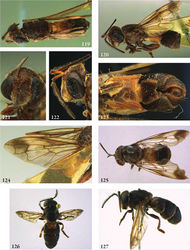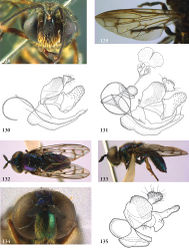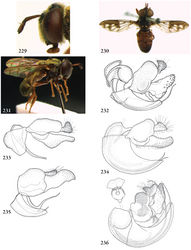Kryptopyga
| Notice: | This page is derived from the original publication listed below, whose author(s) should always be credited. Further contributors may edit and improve the content of this page and, consequently, need to be credited as well (see page history). Any assessment of factual correctness requires a careful review of the original article as well as of subsequent contributions.
If you are uncertain whether your planned contribution is correct or not, we suggest that you use the associated discussion page instead of editing the page directly. This page should be cited as follows (rationale):
Citation formats to copy and paste
BibTeX: @article{Reemer2013ZooKeys288, RIS/ Endnote: TY - JOUR Wikipedia/ Citizendium: <ref name="Reemer2013ZooKeys288">{{Citation See also the citation download page at the journal. |
Ordo: Diptera
Familia: Syrphidae
Name
Kryptopyga Hull – Wikispecies link – Pensoft Profile
- Kryptopyga Hull, 1944a: 129. Type species: Kryptopyga pendulosa Hull, 1944a: 130, by original designation.
Description
Body length: 12–14 mm. Large flies with long antennae (pilose in male) and oval abdomen, which may be constricted basally. Head wider than thorax. Face in profile more or less straight, ventrally produced below eye margin; wider than eye. Lateral oral margins weakly produced. Vertex strongly swollen. Occiput narrow ventrally, strongly widened dorsally. Eye bare. Eyes in male not converging at level of frons; mutual distance about 5 times width of antennal fossa. Antennal fossa about as high as wide. Antenna longer than height of head. Basoflagellomere 3.5-4 (male) or 2.5 (female) times as long as scape; with long pilosity in male, bare in female. Postpronotum pilose. Mesoscutum with transverse suture incomplete. Scutellum semicircular, without calcars. Anepisternum with deep sulcus; pilose anterodorsally and posteriorly, widely bare in between. Anepimeron entirely pilose. Katepimeron convex; with or without wrinkled texture; with rows of microtrichia. Wing: vein R4+5 with posterior appendix; vein M1 in anterior half with outward angle; postero-apical corner of cell r4+5 rectangular, with small appendix; crossvein r-m located between basal 1/6 and 1/5 of cell dm. Abdomen either oval or somewhat constricted at base, in the latter case with tergite 4 curved downward and more or less perpendicular to tergite 2. Tergites 3 and 4 not fused, able to articulate independently. In male Kryptopyga pendulosa, sternite 4 is covered by the genital capsule and therefore not visible without removing genitalia, while the lateral margins of tergite 3 are strongly curved and ‘tucked away’ under sternite 3 (Fig. 123). Male genitalia: phallus slender, furcate near apex, basally complexly bent into curves, interconnected by a membrane; epandrium without ventrolateral ridge; surstylus approximately oval.
Diagnosis
Vein R4+5 with posterior appendix. Postpronotum pilose. Propleuron bare. Mesonotal transverse suture incomplete. Tergites 3 and 4 not fused, able to articulate independently. Anepisternum widely bare of pile (but with microtrichia) medially, also on dorsal half. Male basoflagellomere with long pile.
Discussion
Hull (1944a)[1] erected the genus and assigned one species to it: Kryptopyga pendulosa Hull, 1944. He considered it close to the African genus Ptilobactrum Bezzi, 1915 because of the long pile on the basoflagellomere, but considered it distinct because of the subpetiolate abdomen and the remarkable structure of the 3rd and 4th abdominal segments. The pilose basoflagellomere in the male is also found in Ceratrichomyia, with which Kryptopyga also shares the swollen vertex and dorsal occiput, and the unfused tergites 3 and 4. The male genitalia, however, are quite different, and in Kryptopyga the mesonotal transverse suture is incomplete.
Together with the Nearctic Microdon craigheidi Walton, 1912, Kryptopyga is the only known taxon of Microdontinae in which the phallus is not simply curved between base and apex, but complexly bent into a couple of curves basally, interconnected by a membrane (compare Fig. 131 with Fig. 232). Despite this common character, there is no reason to suspect a closer relationship between these taxa.
The abdomen in Kryptopyga pendulosa is much more modified than in Kryptopyga sulawesiana sp. n., but the latter species is nevertheless regarded as belonging to the genus based on the pilose basoflagellomere, the shape of the head, the wing venation and the structure of the male genitalia, in which it is all very similar to Kryptopyga pendulosa.
Microdon tuberculatus Shiraki, 1968 might also belong in Kryptopyga, because of its unfused tergites 3 and 4 and similarity in head shape (strongly swollen vertex and dorsal occiput, face ventrally produced below eye margin). However, only the female of this species is known, so it is unknown whether the male has long pile on the basoflagellomere and the characteristic genitalia of Kryptopyga. Therefore, this species is presently left unclassified. As de Meijere (1913)[2] had already used the same species name, the replacement name shirakii is here proposed.
Diversity and distribution
Described species: 2. Indonesia: Bangka, Java and Sulawesi.
Taxon Treatment
- Reemer, M; Ståhls, G; 2013: Generic revision and species classification of the Microdontinae (Diptera, Syrphidae) ZooKeys, 288: 1-213. doi
Other References
- ↑ Hull F (1944a) Some genera of flies in the family Syrphidae. Journal of the Washington Academy of Sciences 34: 129-134.
- ↑ de Meijere J (1913) Dipteren I. Nova Guinea 9: 305-386.
Images
|


